Mecca. Part One. Prestanding
Mecca is a city in Saudi Arabia.
Mecca is the center of the Muslim world. The main mosque of Islam is located in this city, and inside the mosque stands a huge black cube called the Kaaba.
Every time Muslims pray, i.e. perform salah or namaz, they face towards Mecca. The prayer is not considered heard by Allah if a Muslim was looking in other direction.
In addition, Mecca has a unique feature. Only Muslims are allowed to enter the city. Along the roads leading here, hang the signs: “Only for Muslim”. At the approaches to the city, a patrol may stop and ask for proof of one’s faith. If a non-believer is identified in Mecca, he at best will be stoned, imprisoned, and deported.
That is why Mecca is considered the Holy Grail for travelers. Many non-Muslims would like to visit this forbidden city, but in all of history only a couple dozen people have dared to do this. Just a few have written about it.
Well, shall we go?
How to visit Mecca as a non-Muslim
For a Muslim, there are two ways to enter Mecca. One must either obtain a visa to Saudi Arabia or go on a pilgrimage.
In any case, when filling out a visa application, one must indicate his religion, which will then be printed on the visa itself and pasted into the passport.
If the reader is Tatar, Chechen, or Uzbek, they will not have any problems. It is enough to write the word “Islam” in the religion field. The embassy will see a Muslim surname and issue a visa.
If the Reader has a European, American, Russian or Chinese surname, he will be asked to confirm that he is indeed a Muslim. To do this, one must go to a mosque and obtain an absurd document: a certificate of conversion to Islam.
By the way, accepting Islam is very simple.
The first Islamic marketers wisely reasoned that it is not worth narrowing the sales funnel too soon. To accept Islam, there is no need for circumcision or knowledge of the Quran. To convert to Islam, one simply needs to go to the mosque and ask the duty imam about it.
The imam will not ask anything. He will give you a tired look and ask you to recite the Shahada — a famous phrase, a testimony of the Muslim faith.
In our time, any intelligent person should know the Shahada in Arabic. In English translation, it sounds like this: “I bear witness that there is no deity but Allah, and I bear witness that Muhammad is the Messenger of Allah.” However, Islamic marketing now is such that one may not even know the Shahada. The imam will say it syllable by syllable. One simply needs to repeat it.
After pronouncing the last letter of the Shahada, you will immediately become a Muslim, and all your sins will be forgiven. Even if an hour ago you ran over an old lady with a truck.
Now all that remains is to go to the heavenly office near the mosque and ask for a certificate. The titled paper in two languages will state that you have converted to Islam and undertake never again to eat with your left hand.
But have you really accepted Islam? Of course not. In Islam, even prayer is not considered accepted if there was no sincere intention clearly expressed to oneself. Therefore, the certificate for you is just a blank piece of paper, a visa supplemental.
And knowing the format of the certificate, you can even create it yourself and print it on a printer — I guess no one will check.
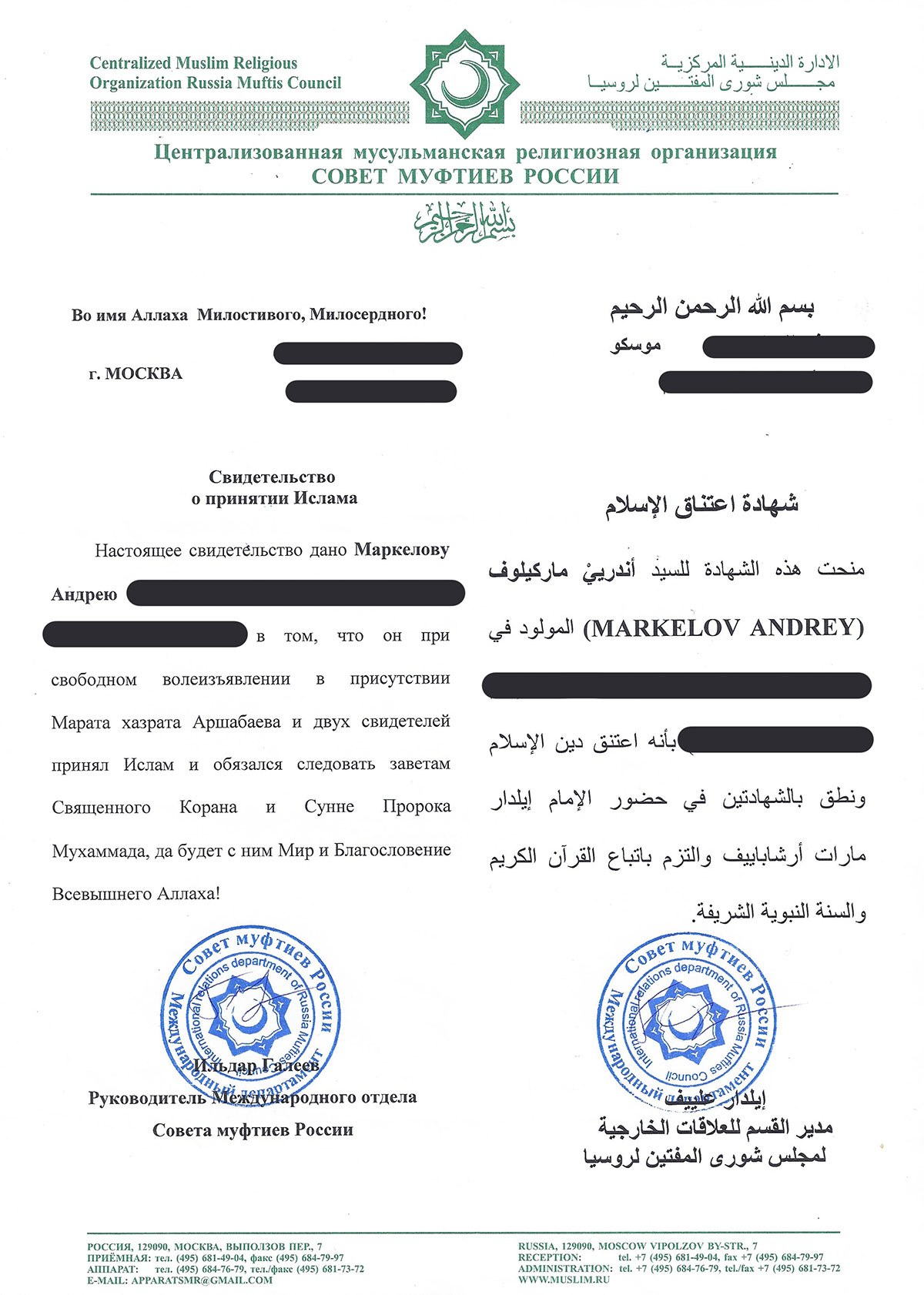
With this “supplemental,” the way to Mecca is open. However, before going to Saudi Arabia, it is still necessary to learn at least two or three prayers in Arabic and remember how to make salah.
It is not that difficult. In non-Arab countries, 86% of Muslims themselves do not know what they are saying during the prayer. They simply memorized a set of sounds. As for the technique of performing salah, well. Every Sunday, free coaching “Namaz in an Hour” takes place in Moscow Cathedral Mosque.
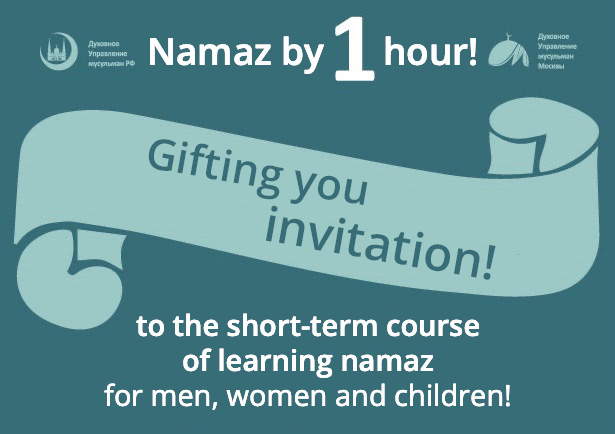
That’s it. You can buy a pilgrimage tour and go to Mecca. There are two types of pilgrimages: Hajj and Umrah. Hajj is too difficult even for devout Muslims and is performed once a year in incredible crowds, while Umrah is a hipster version of Hajj, which can be completed at any time of the year.
During the pilgrimage, you will walk, eat, sleep, and live in the same room with three Muslims and a guide for 10 days. You will wear strange clothing without underwear and pray five times a day, bowing your head to the ground.
Like I said, very simple. Piece of cake.
The ban that never existed
Now listen.
The ban on visiting Mecca is prescribed in the Quran.
It seems that the ban is formulated unambiguously and accurately, but do not rush to conclusions.
The Quran is considered a book of absolute truth that contains answers to all questions. Sharia, the legal system of Islam, is based on the Quran. But there is one problem. Although the Quran provides answers to all questions, these answers are written in complex verses scattered throughout the book. These verses can be understood differently.
Therefore, by the 10th century, various readings the Quran had accumulated, and four schools emerged: Hanafi, Hanbali, Shafi’i, and Maliki.
The largest is the Hanafi school. It includes Turkey, all Central Asian countries, and Russia except for Chechnya and Dagestan. The schools do not antagonize each other. Each school recognizes all others as legitimate.
So, the founder of the Hanafi school, Abu Hanifa, interpreted the verses about the Forbidden Mosque in his own way. He said that non-Muslims can visit Mecca if they are not performing pilgrimage. And this is the official position of the Hanafi school, which all other schools must respect.
It comes that the ban on visiting Mecca is nothing more than a local law of Saudi Arabia.
Miqat
Morning in Medina.
Along the city streets, dozens of pilgrims gather at the doors of each hotel. They are dressed in all white, ritually clean and scented. The strange attire is called ihram and consists of two towels. There is no clothing under the towels, only bare skin. The garment is woven without needle and this is why it’s sacred.
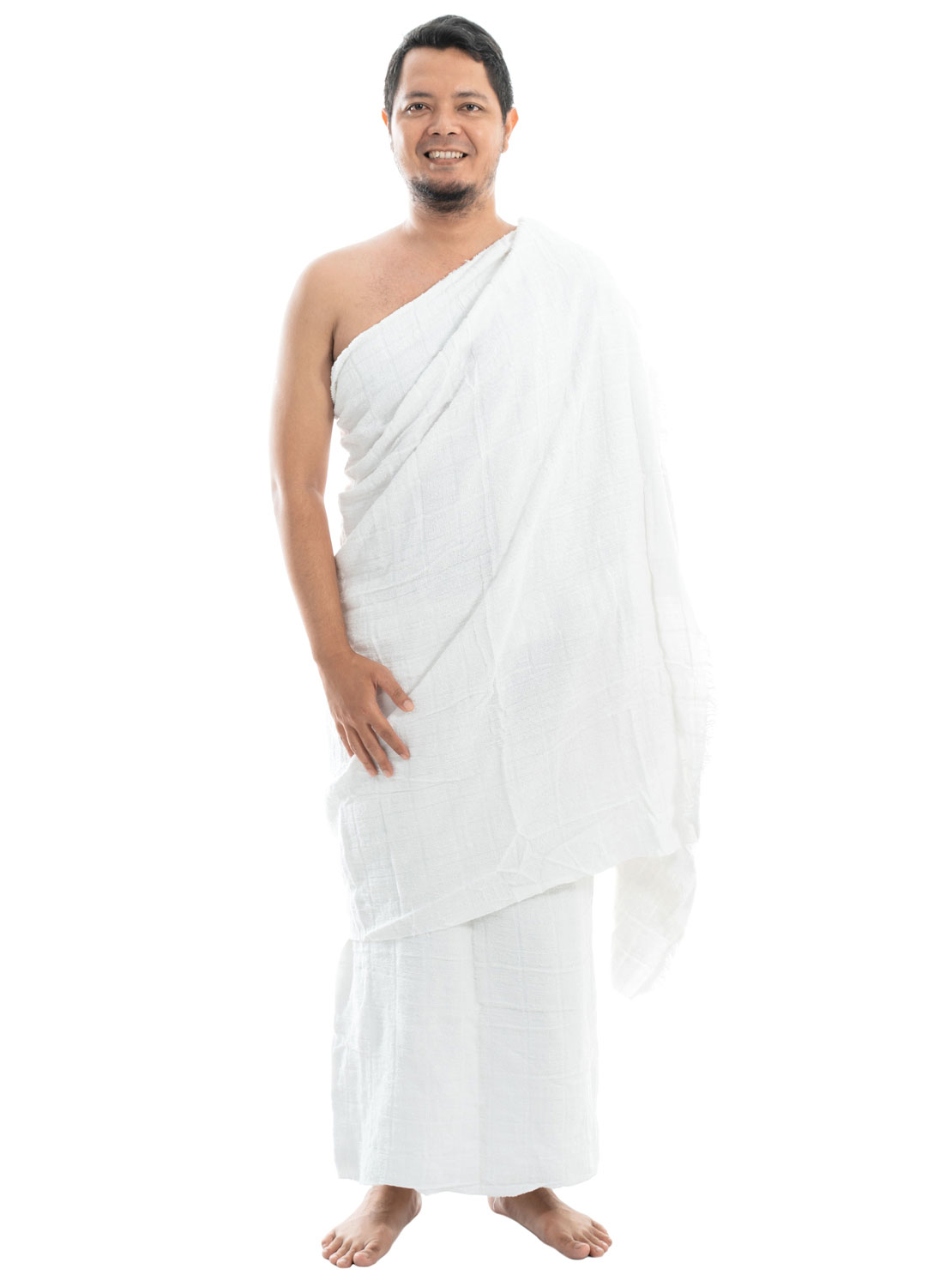
In their costumes, the pilgrims resemble departed righteous who have gathered in heaven waiting for the reception. Only it is not the gates of paradise that open before them, but the doors of a bus heading to Mecca.
A pilgrim cannot enter the forbidden city without undergoing a special ritual. Mecca is surrounded by a system of “checkpoints” called miqats. These are sacred places where it is prescribed to perform a special prayer and enter a state of spiritual purity. The bus turns off the highway and enters the miqat of Hulayfa. It is located to the north of Mecca and is intended for pilgrims arriving from the north.
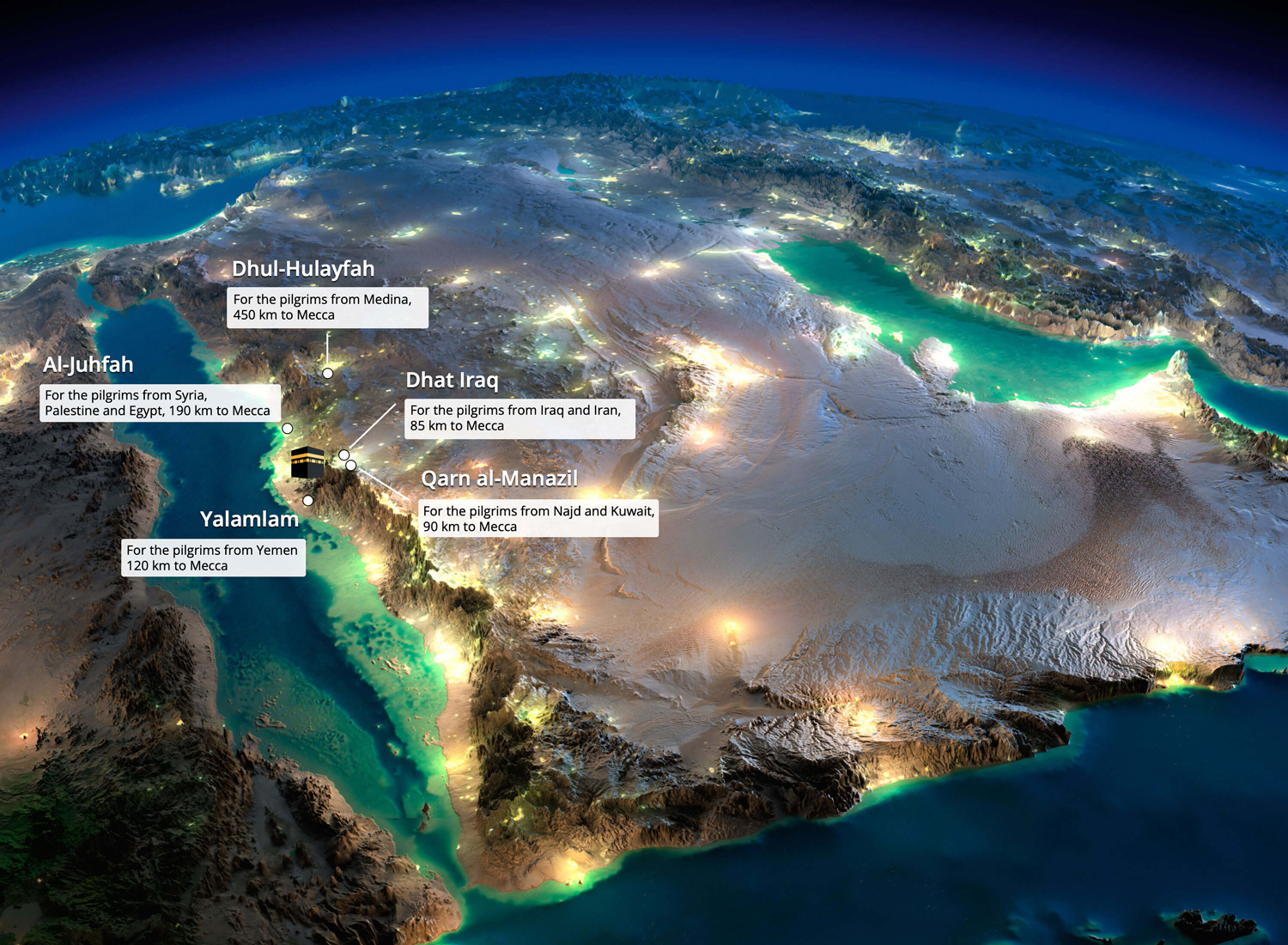
At the miqat, blood starts flowing from my nose. I run out from the hall in horror, clutching my nostrils with hand so as not to stain the show-white dress.
A believer would call it a bad omen. I know that the bleeding is due to the temperature change. It’s freezing cold on the bus, while outside it’s unbearably hot. After five minutes, the burst vessel heals, and the bus goes on. Now we are going straight to Mecca without any stops.
No matter how long the pilgrim’s path to Mecca may be, all the way he must repeat the talbiyah — another strange Islamic spell. The guide picks up the microphone and begins to utter words in Arabic. People on the bus try to convey similar sounds as best they can.
“Here I am at Your service, O Allah, here I am!” — pilgrims around me recite this prayer aloud, gradually falling into trance.
The scale of the catastrophe reaches its peak, and I see Buddhist monks singing mantras. Outside the window is the desert, an earthborn vacuum. The sky rolls up with thunderclouds. Will it rain in Arabia? Will it be in my honor?
I move my lips to the rhythm, but amidst this barren desert, another prayer drowns out my thoughts. Kashmir. Led Zeppelin. “I am a traveler of both time and space, to be where I have been.”
Kaaba
“When you open your eyes and see It for the first time, you’ll want to cry. Don’t hold it in. This will be a good sign.”
The Kaaba stands at the very center of the Forbidden Mosque, which, like a citadel, grows around itself and devours Mecca.
The Forbidden anthill! The network of entrances and exits is entwined inside Al-Haram. The path to the Kaaba goes through basements which resemble hospital corridors. Narrow and low, covered with greenish tiles, with icy floors and dim lighting — the corridors of the zero floor create an atmosphere of a morgue.
“Everyone close your eyes and hold hands! I will tell you where to go.”
The last minute pilgrims are led in chain, blindly. A date with the dream should be special. Finally, feet are feeling warmth. The cold floor has ended. We have come out somewhere and stopped.
“Open your eyes!”
All sounds muffle as when diving under water. The view shrinks to the size of a movie frame. A black cube hits the eyes with light.
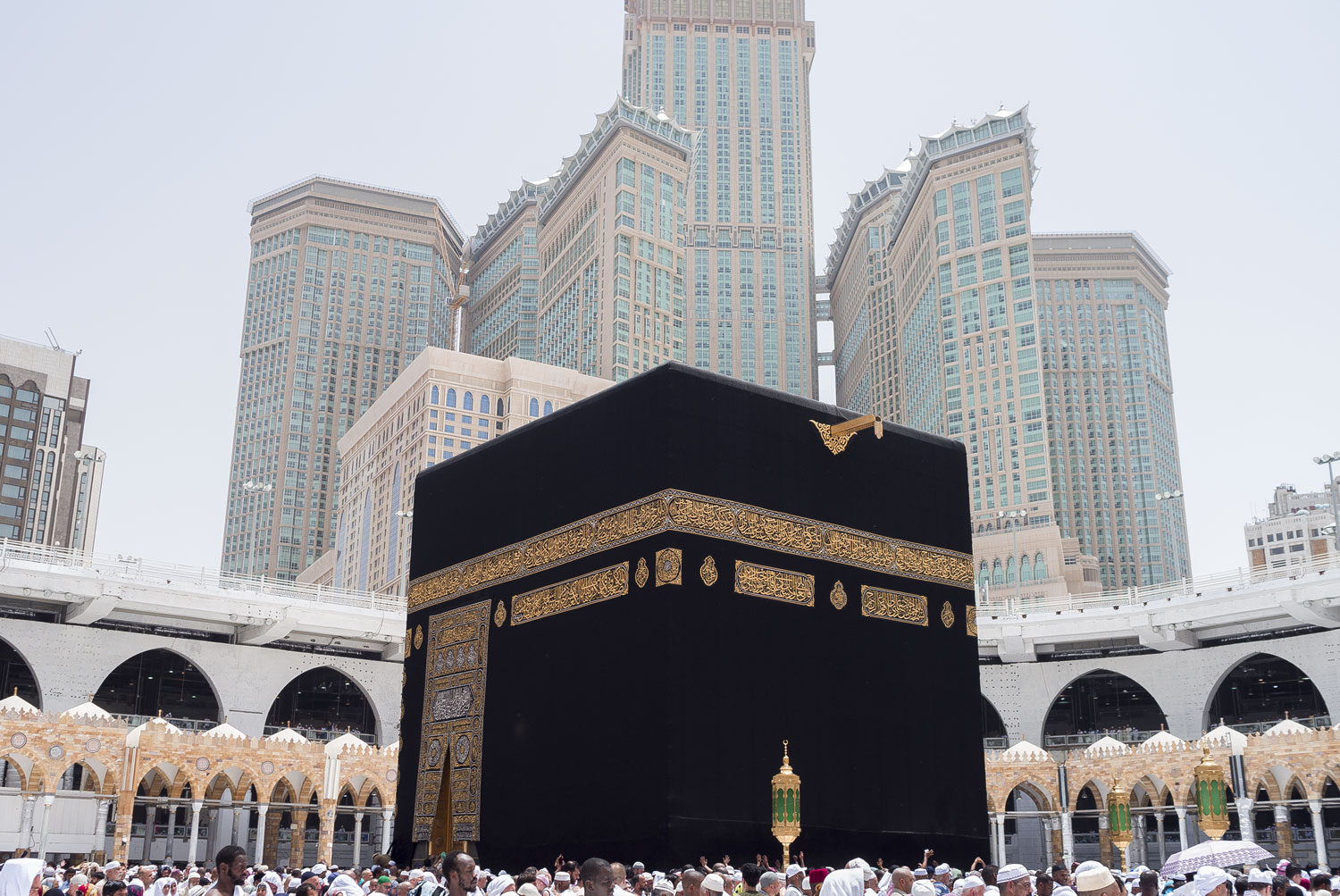
For fifteen hundred years already, if not more, a continuous roundelay of pilgrims has been rotating around the Kaaba. It began when Arabia was still pagan and continues to this day, in long-ago Muslim Mecca.
Day after day, around the clock, thousands of Muslims come to the Forbidden Mosque to circumvent the sacred Kaaba 7 times counterclockwise. This ritual is called Tawaf. It is an integral part of Hajj pilgrimage.
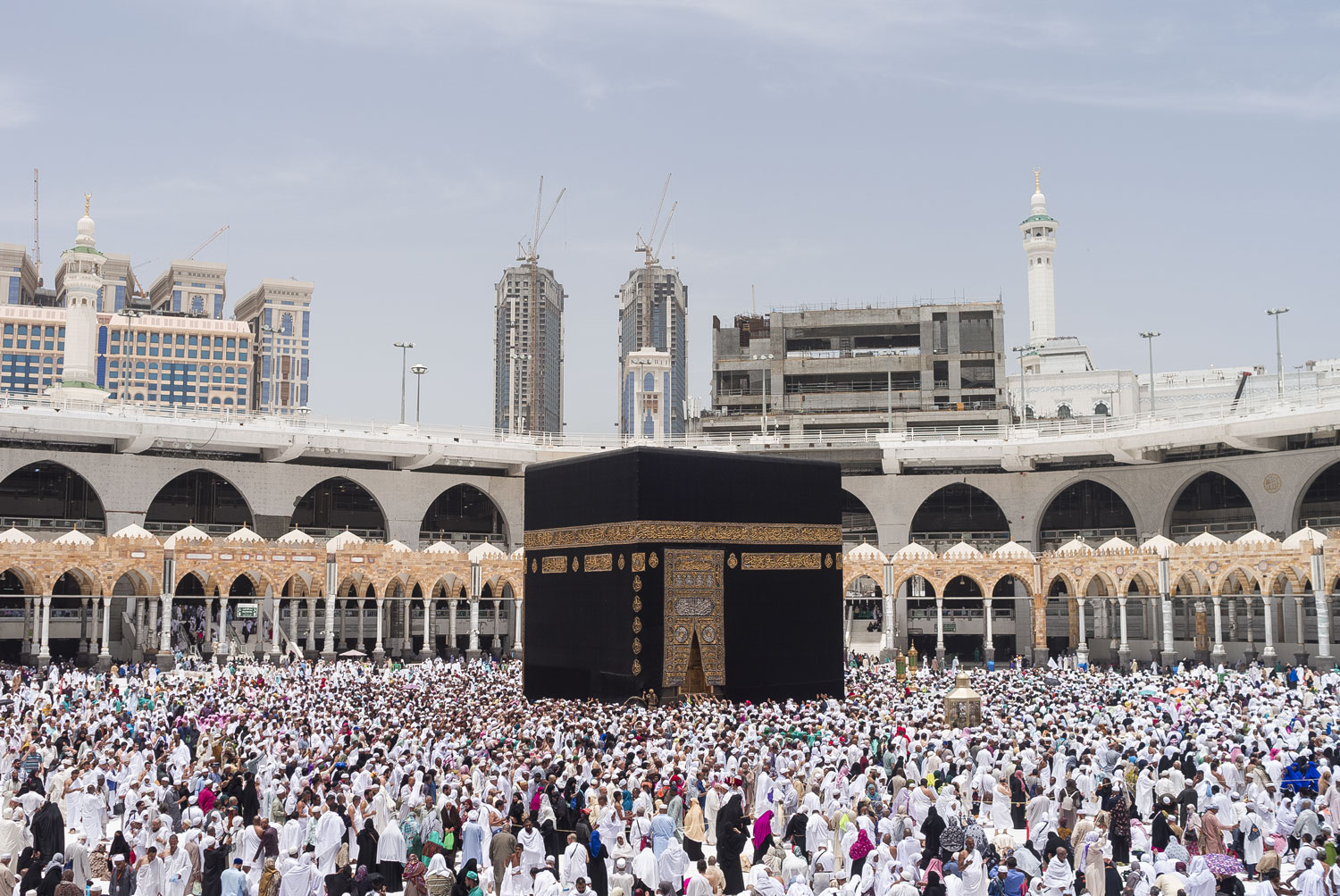
I forget to take off my shoes and immediately plunge across the endless stream of people. At the edges of the circle, the flow is not as dense, and it is easy to pass through it. But the closer to the center, the harder it becomes to break through the ring of pilgrims. The crowd becomes too dense, and it is no longer possible to walk straight through. I have to give in to the stream.
For several laps I am carried in the flow. Prayers are heard from all sides, and each group of pilgrims reads them their own way. The cacophony of outcries: ”Allahu Akbar“ — and snippets of prayers resembles the Doppler effect. Here comes one group. The singing increases until it reaches a peak volume as the group passes by me. The group moves away, their prayers decrease in frequency and gradually fade. But here is approaching another one.
Mad crowds and stampedes are commonplace in Mecca. Thousands of people constantly walk around the Kaaba. At the same time, Mecca is unbearable hot all year round, with temperatures reaching up to 50 degrees Celsius and humidity of 100%. The white marble tiles that cover floors everywhere in Arabia get overheated by the sun. One could cook English fried eggs with halal on it, and it burns your feet from single touch.
But the crowds swarming around the Kaaba obscure the sun. Through the dense stream of bodies, heads, and feet, sunlight can hardly pass. The tiles under the pilgrims’ feet are always in the shade and don’t have time to heat up.
Heat stroke takes over the head and body. There’s nothing to cover the head from the sun. The closer to the center, the more tightly people huddle together. On the way to the Kaaba, Muslims walk on their own feet, and it is impossible to lift hands up. No oxygen is left over the endless crowd: pilgrims have exhaust it all over a thousand years of their round dance.
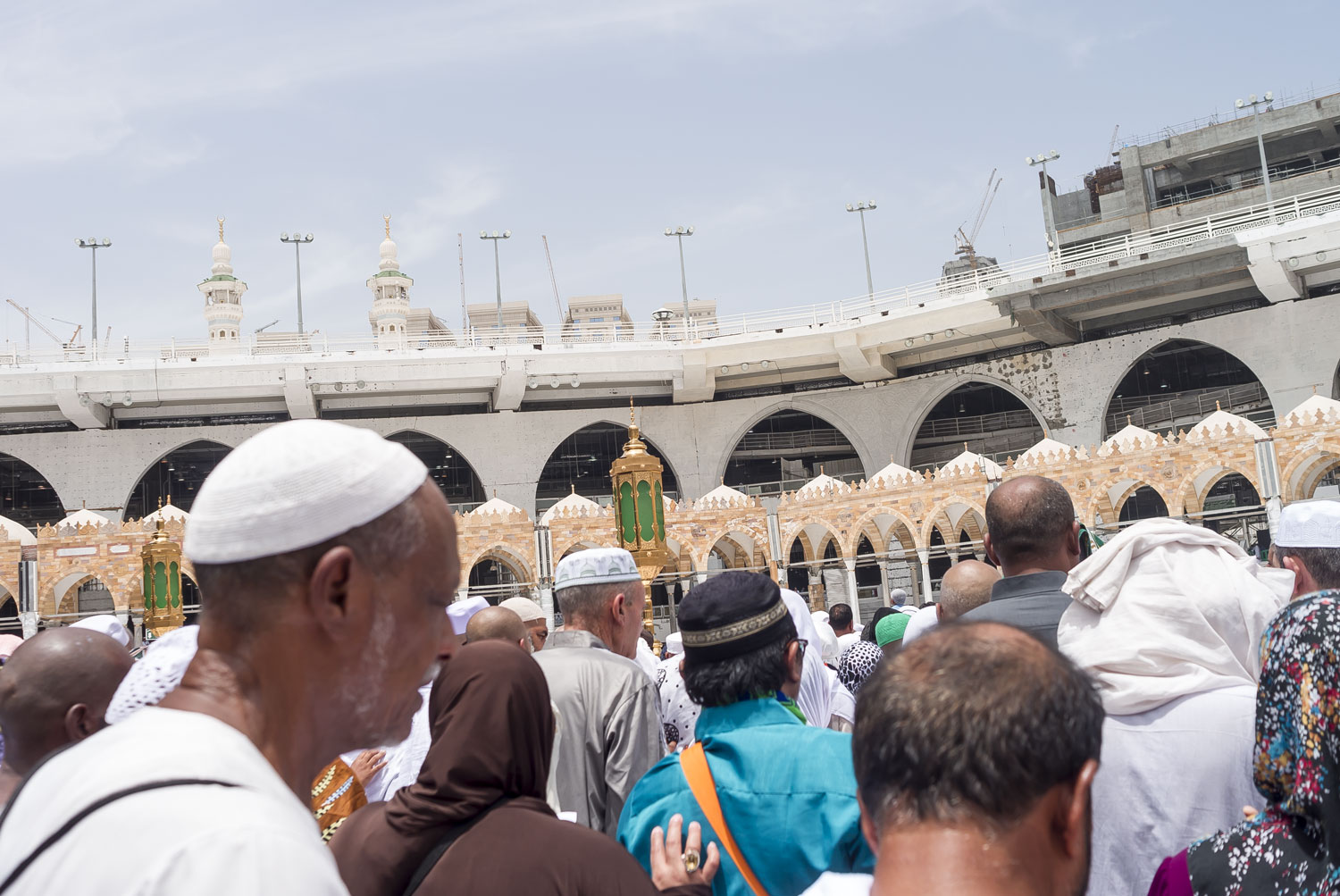
People fall in faint. From heatstroke, from sunstroke.
I’m going through the second turn of my spiral in this human hurricane. A woman floats past me, unconscious on the floor. Pilgrims stumble on her with their feet, go around, and move on. Two people rushing up to help. They sit the woman up and sprinkle her with holy water, barrels of which are scattered throughout the mosque.
In ten minutes, she will come to her senses and continue, staggering, walking circles around the black cube. Pilgrims cannot be stopped. Fainting is a challenge from Allah. Death during Hajj is the greatest gift and a direct ticket to paradise.
I'm being carried around for some few cycles. I try to walk diagonally and slowly approach the Kaaba. Its walls, covered with a black mantle, are getting closer. The crowd of pilgrims is getting thicker. The crowd cries and sobs. The pilgrims howl and moan. They are only a centimeter away from the Kaaba, the Divine Kaaba, towards which they have prayed every day for decades. There she is! With cry and tears, they reach their hands, dreaming of at least by tips of fingers to touch her mantle.
I have another goal: I take out a miniature “Leica” from my waist bag, which was noticed by none of the guards at the entrance to the mosque.
“Hey you, people come here to pray, not to take pictures! Touch it and pray!”
Having taken several pictures, I hide the camera and touch the Kaaba.
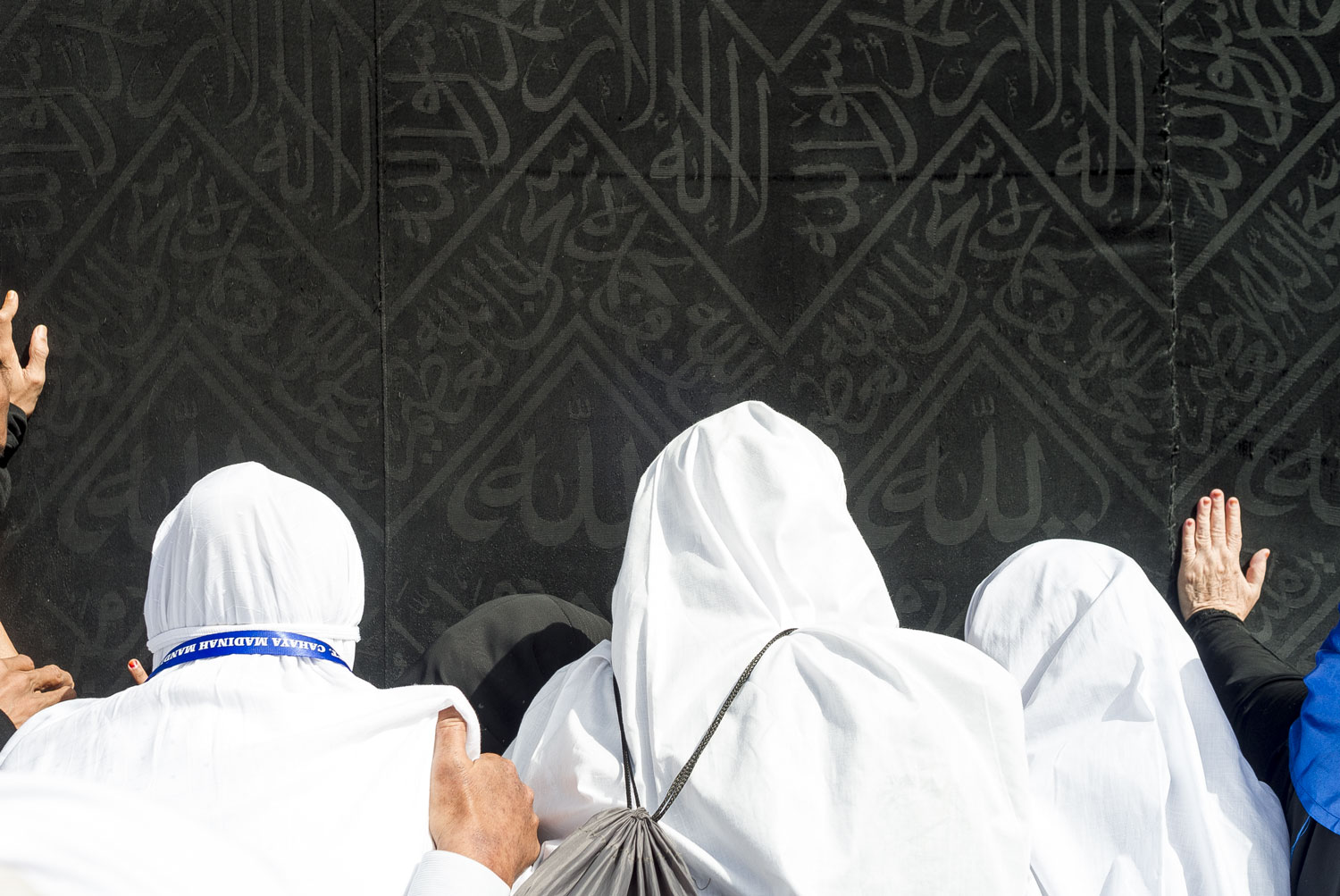
The cube is covered with a thick black mantle sewn from silk. The Arabic pattern with the Shahada is embroidered all over the mantle. At the very top, along the perimeter, the fabric is stitched with golden threads of prayers from the Quran. The mantle plays and shimmers in the sun.
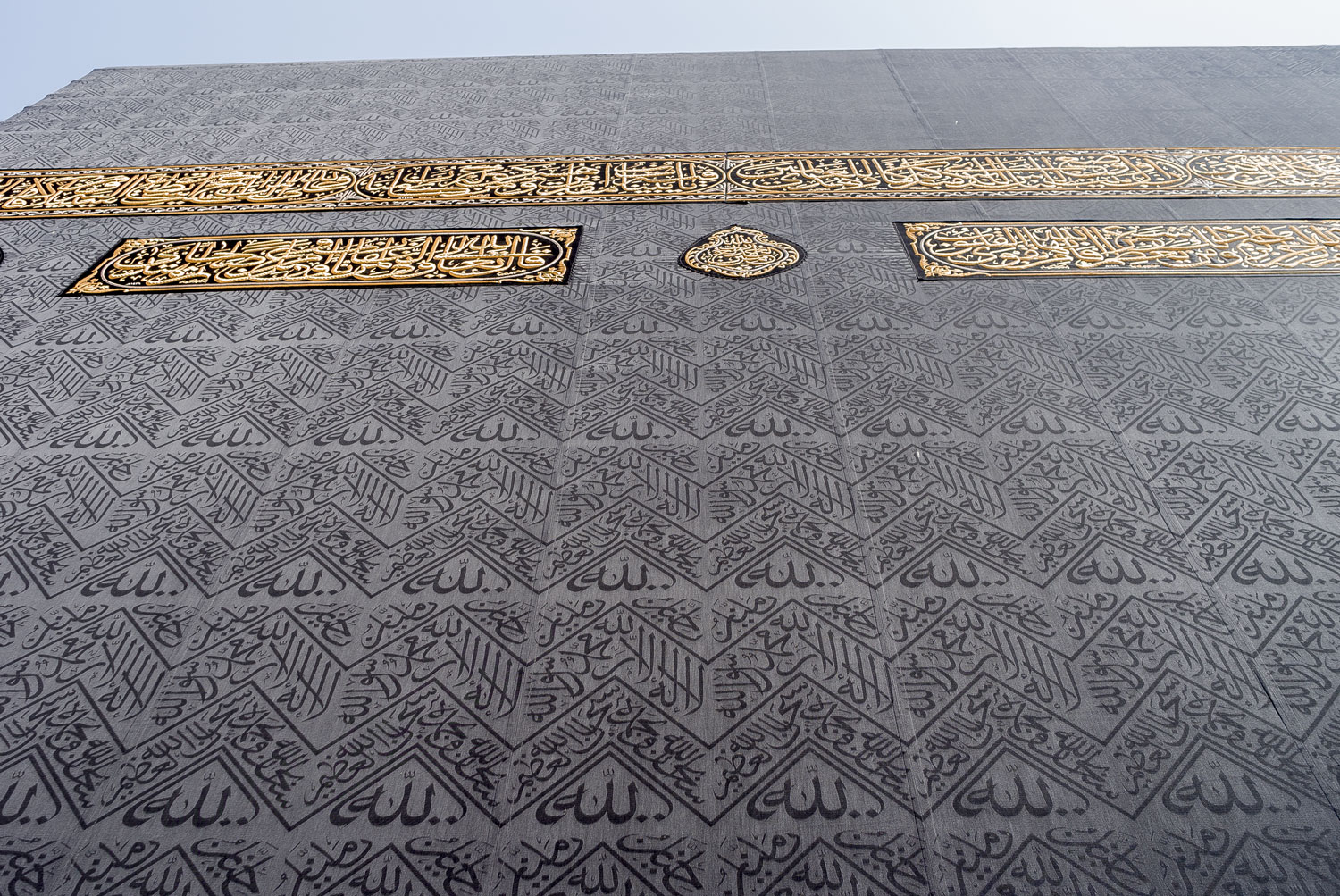
If a Reader of any religion were to find himself in Mecca, he would admit: Kaaba is incredible.
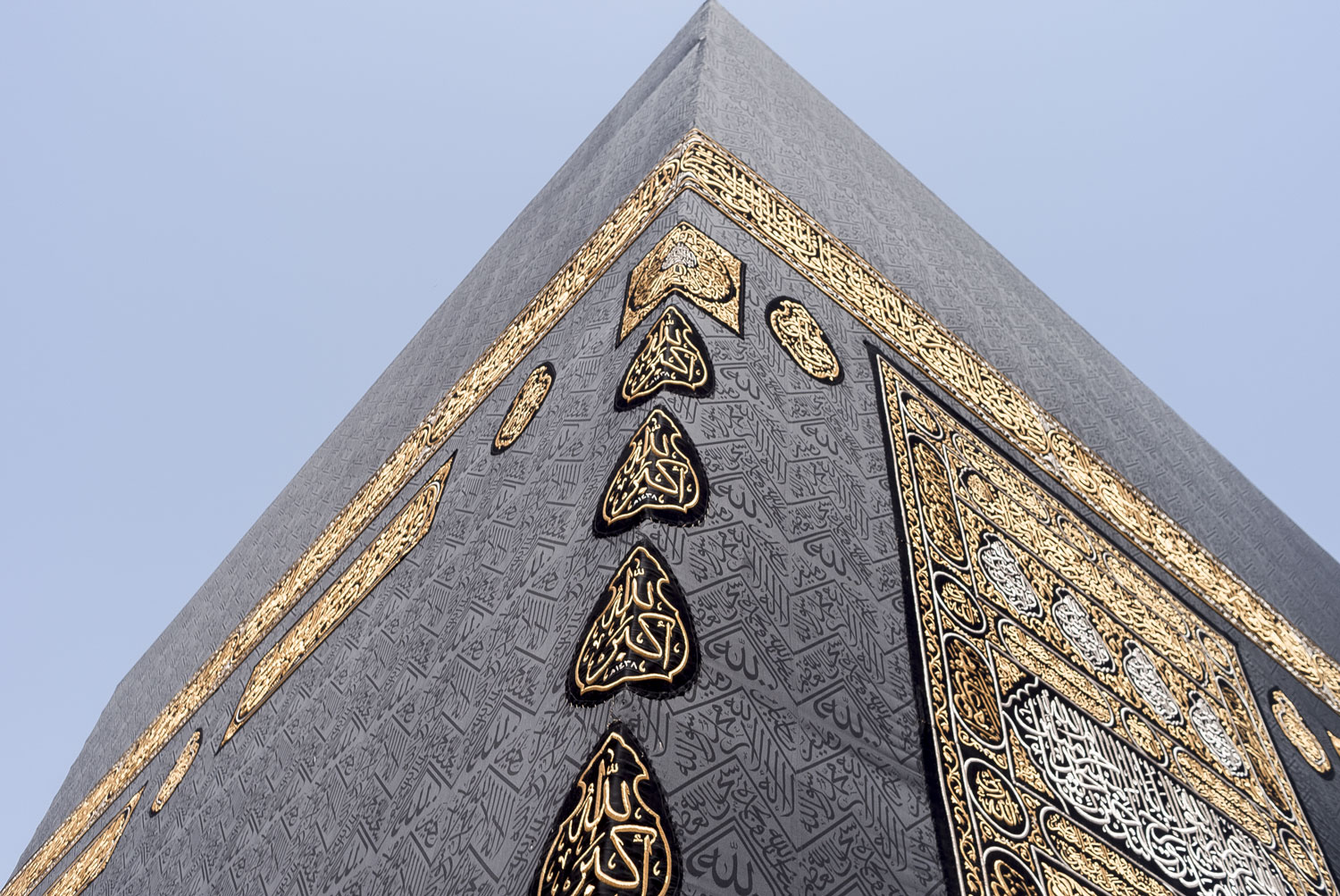
Pressing against the wall, I walk around the Kaaba. On the other side is the entrance inside, which is closed by grandiose golden doors. Here, the mantle is stitched with gold from the ground to the sky, and an oblique cut is made around the doors.
Pilgrims’ hands are reaching for the doors. Even more people want to touch the doorstep — this place is considered special for prayer. Getting closer is too difficult. The crowd presses and pushes back.
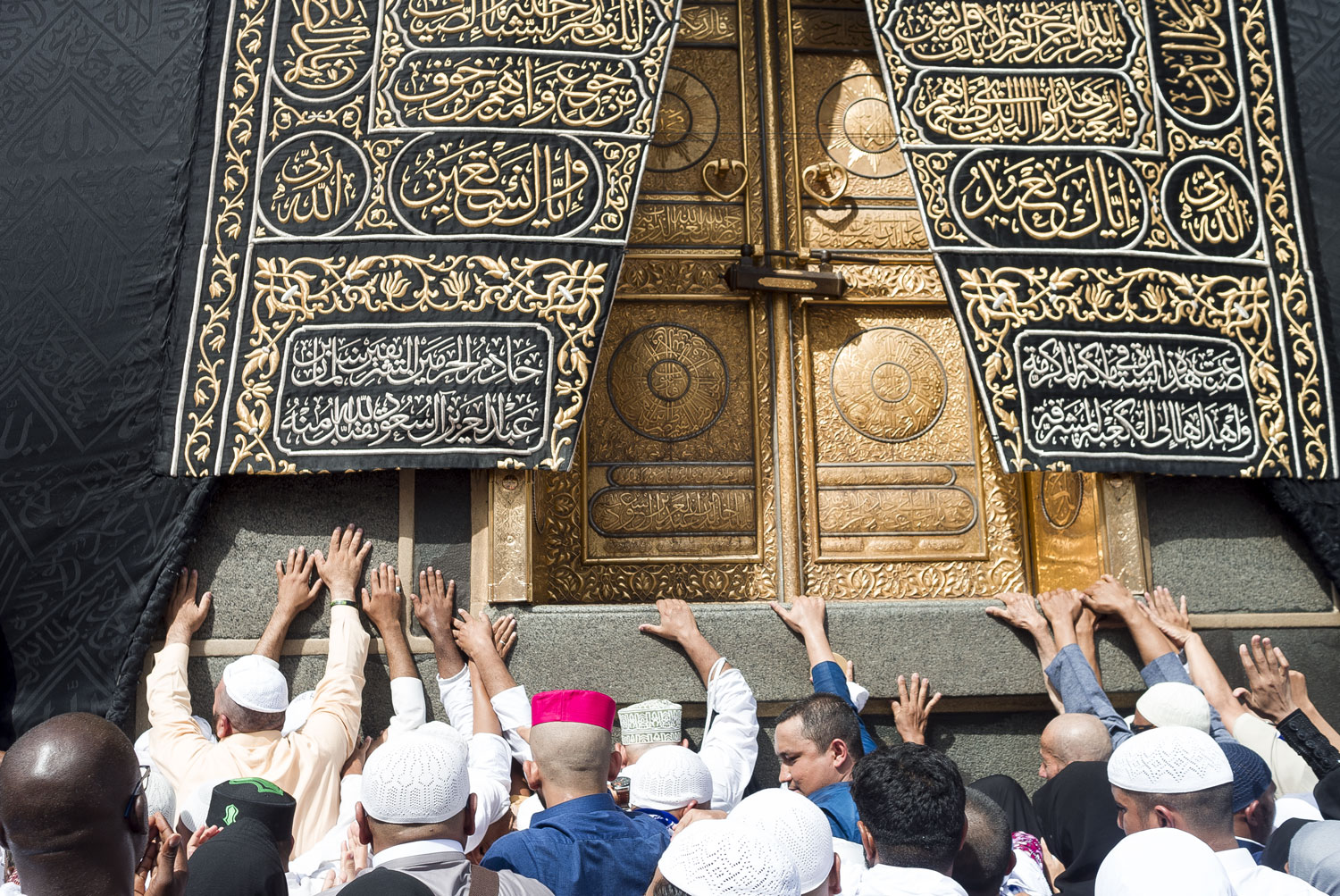
I manage to break through by force to the doors, and touch the entrance. Under the mantle of the Kaaba hides a stone building. The stone feels rough and soft to the touch. Basalt?
In the hysteria of prayers and happy crying, no one notices how I take out the camera again and take pictures that I never even dreamed of.
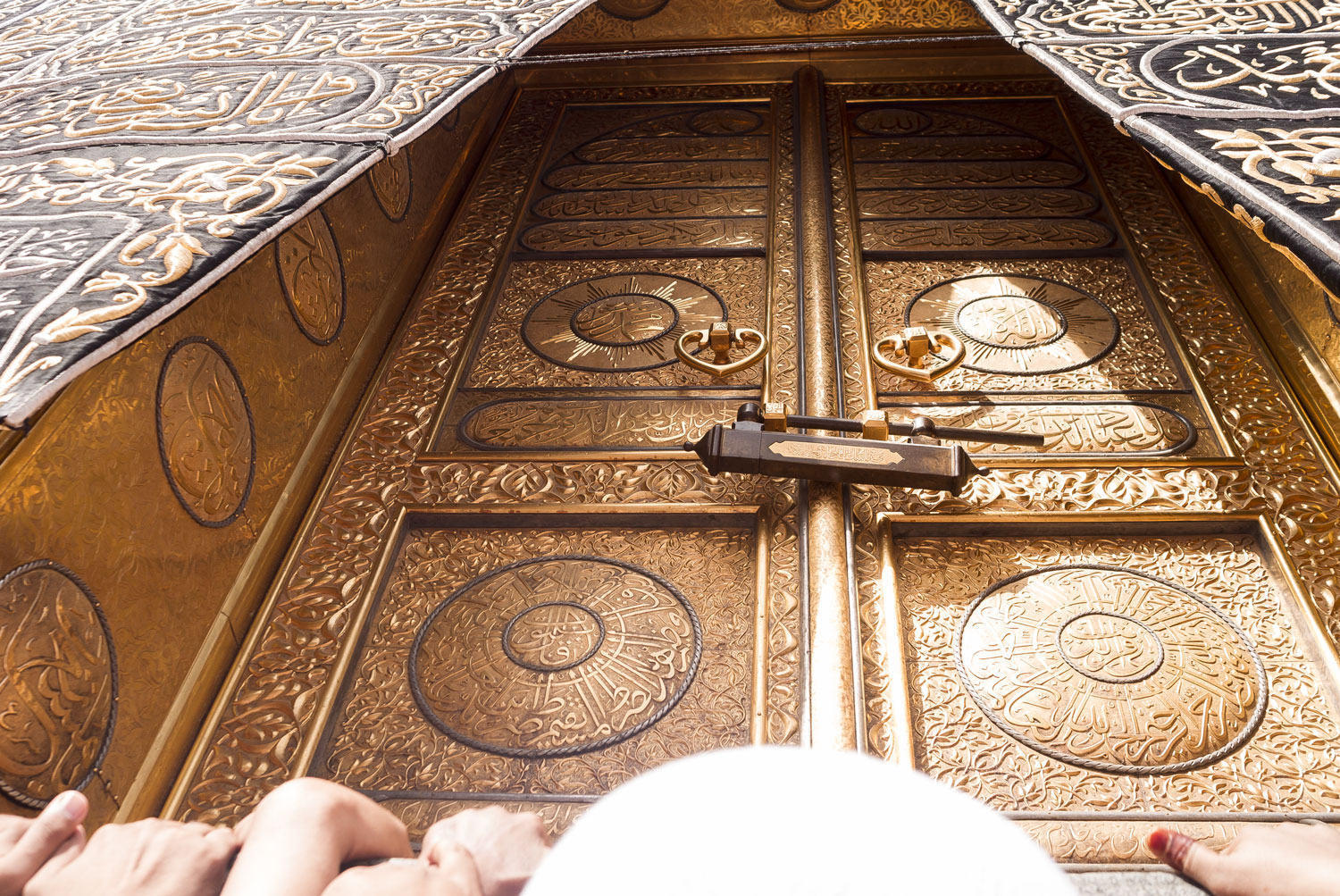
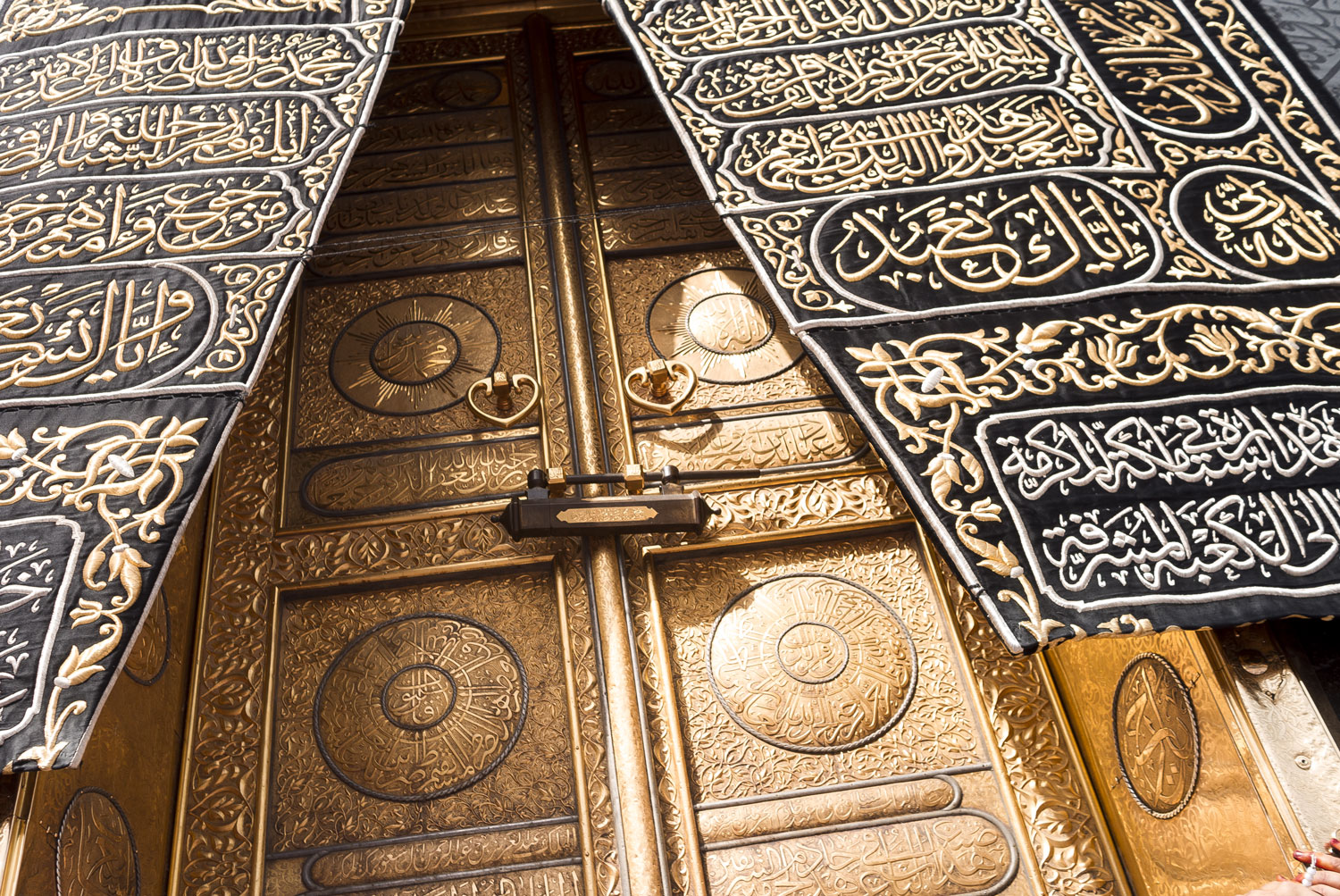
A policeman sees me, while standing at the doors. He can’t break through the crowd anyway, but I hide the camera again and pretend to pray.
A ledge is made near the doors. The policeman stands on it as on a pedestal, putting his left hand through a special loop that comes out from under the mantle. The policeman looks at the crowds of believers as if they were cattle, pushing them away with his baton. A patrol walks nearby, pulling away most arrogant fanatics by the scruff of their necks.
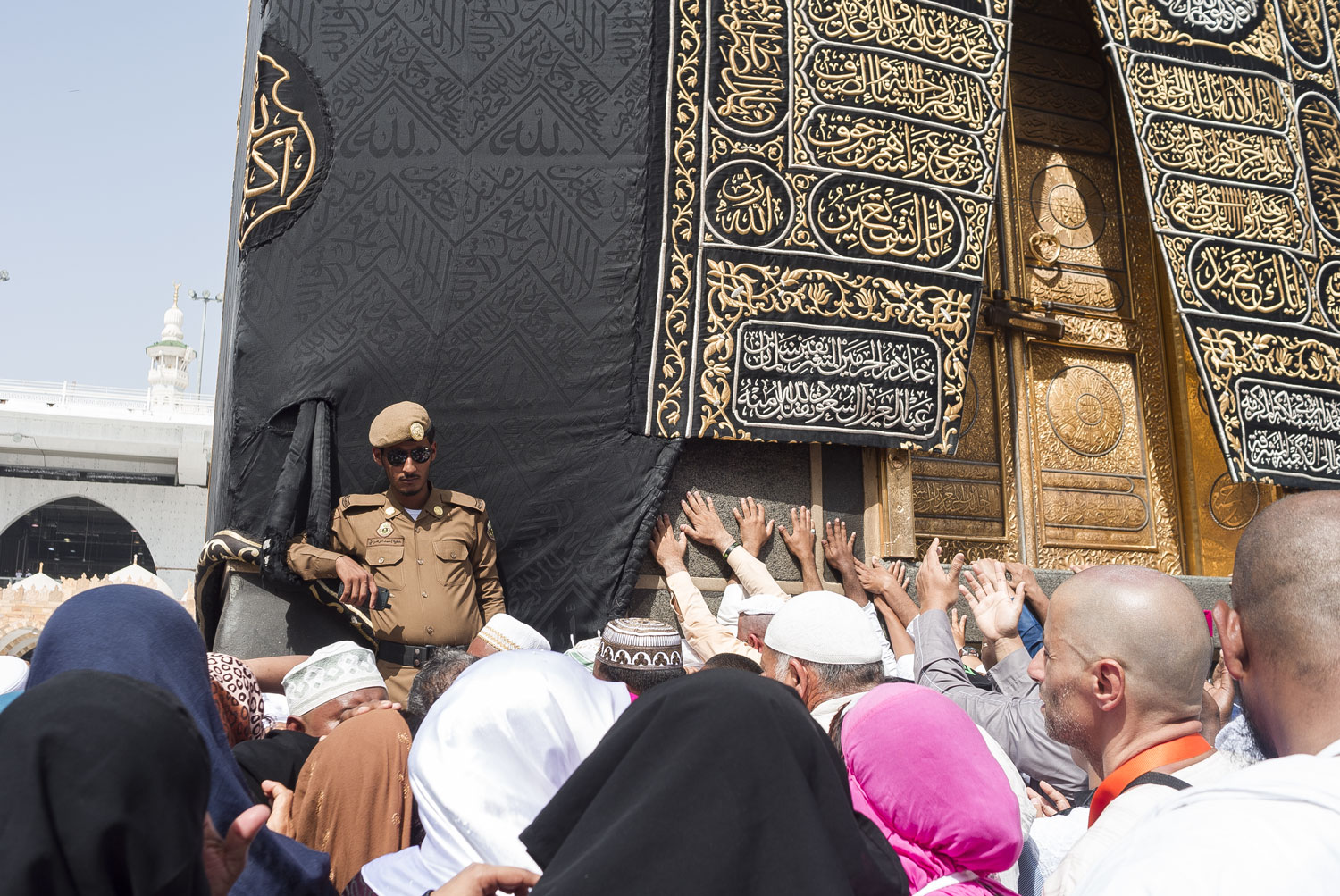
I have to move against the flow to the corner, but I cannot beat the crowd. It carries me away again, and here I am in another twist of the human funnel.
On the other side of the Kaaba is a semi-circular fenced square. Inside this pound, a clot of crowd where people fall in prayer. A policeman stands on duty at a small gate, whe lets people into the pound in small portions. The semi-circular fence around it is called “Hateem”. Muslims believe that the prophet Ishmael and his wife are buried here, so every pilgrim wants to pray in Hateem.
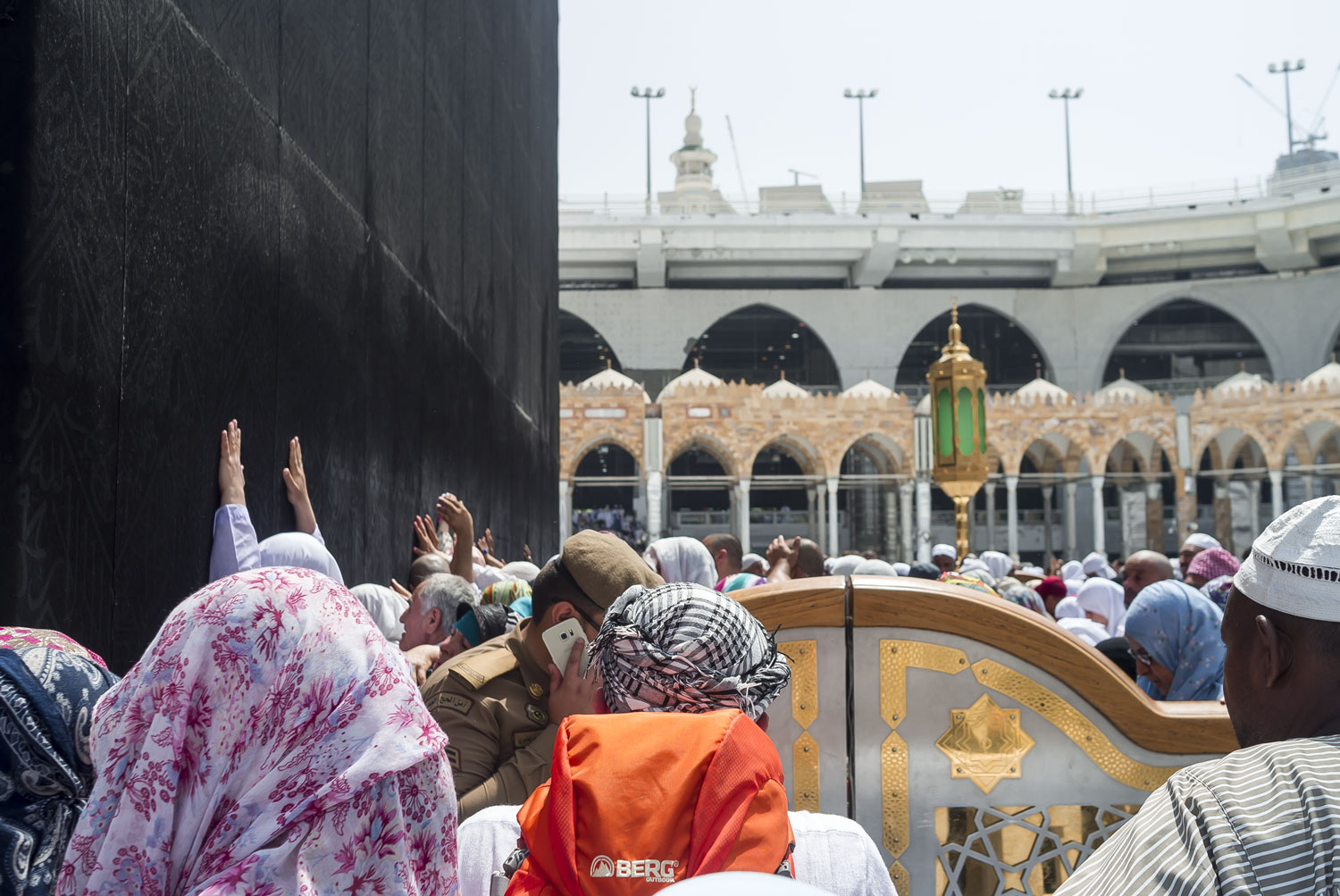
But the small yard of Hateem is crowded as a subway car during rush hour. There is no place to even put your feet, but the task is to bow down to the ground and pray!
And so the prayers bend triple here and try to do salah. There are several lifehacks to pray in the Hateem. If there is somebody standing in front with legs crossed, you can make a bow slightly to the left and fall on his shoes. If the legs are shoulder-width apart — what a luck: you can put your head between them. The main thing is to watch your hands. They can get crushed.
I swim past the Hateem. An unconscious man is carried out of the gate. To pray in this enclosure is like diving underwater. You need to take full lungs of air and only then sink to the bottom. There’s nothing to breathe down there. People lose consciousness, and they are not noticed right away — it’s hard to see someone lying in the crowd.
A policeman appears from the human whirlwind with two bottles of water. Seeing the Messiah, the pilgrims reach out their hands to the water. The policeman, with a smile, throws one bottle into the crowd; then the second. Begins a battle. Less than a minute passes: both bottles are empty.
The mad Hateemm is left behind, and I make a full turn around the Kaaba.
It wails anew, the discordant prayer choir of thousand Muslims. Only one thing unites the cacophony. Passing by the corner of the Kaaba adjacent to the doors, a radius of people synchronically kisses their palm and blows an air kiss to the Kaaba, saying:
“Bismillahi, Allahu Akbar!”
The Black stone
The Black stone is embedded in that corner. Muslims believe that the stone fell from heaven and was once white, but turned black from human sins. Scientists consider it a meteorite.
In pre-Islamic Arabia, the Black Stone was the main idol that united all Arab tribes. After the victory of Islam, it was decided to leave the stone and embed it in the Kaaba. It was of such great importance to the polytheistic Arabs that remained relic in Islam.
The Hajj prescribes the pilgrim to kiss the Black stone. However, the crowd around it gathers twice as dense as it was in Hateem, making it almost impossible to do.
The Black stone is surrounded by a clot of true fanatics. One of the pilgrims decided to touch the stone at all costs and climbed onto the pedestal to the policeman. He was quickly punched in the forehead, got a scratch. After that, the poor man was grabbed by his arms and legs, like Jim Morrison jumping offstage, and thrown into the crowd.
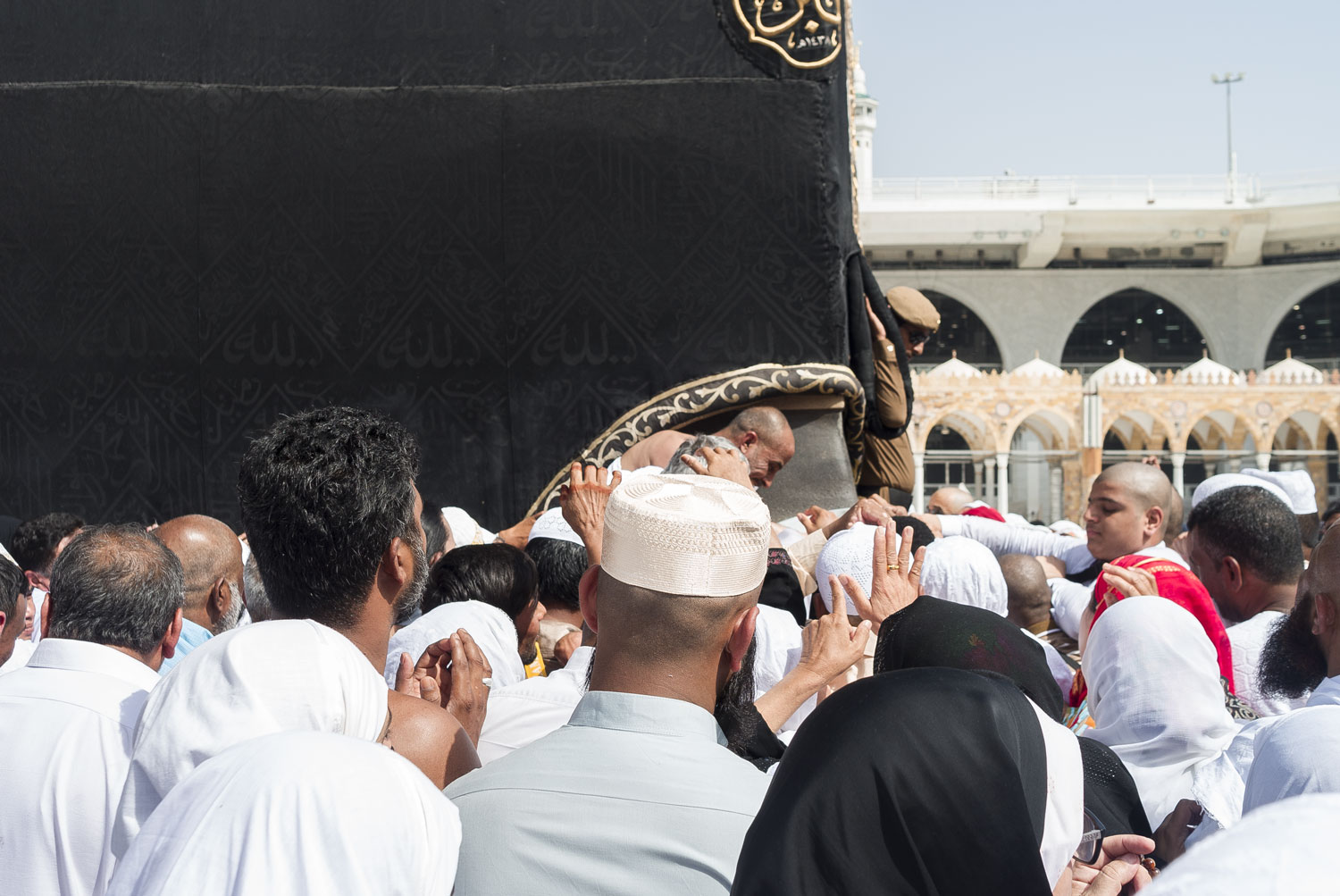
I tried to approach the stone. Kissing it was not in my plans: I remember well the biological analysis of icons in churches. But I wanted to touch it with my hand.
Getting closer to it even at arm’s length was impossible. A meter away from the stone, the crowd squeezed me with such force that it became difficult to breathe. The pressure caused pain and stitching in my chest. The lower row of the thinnest and softest ribs bent inward. The grip of the crowd became bearish. It seemed my ribs would crack and break now. With all my strength spreading elbows to the sides I managed to push the crowd apart. The counterreaction threw me to the stone like a ball.
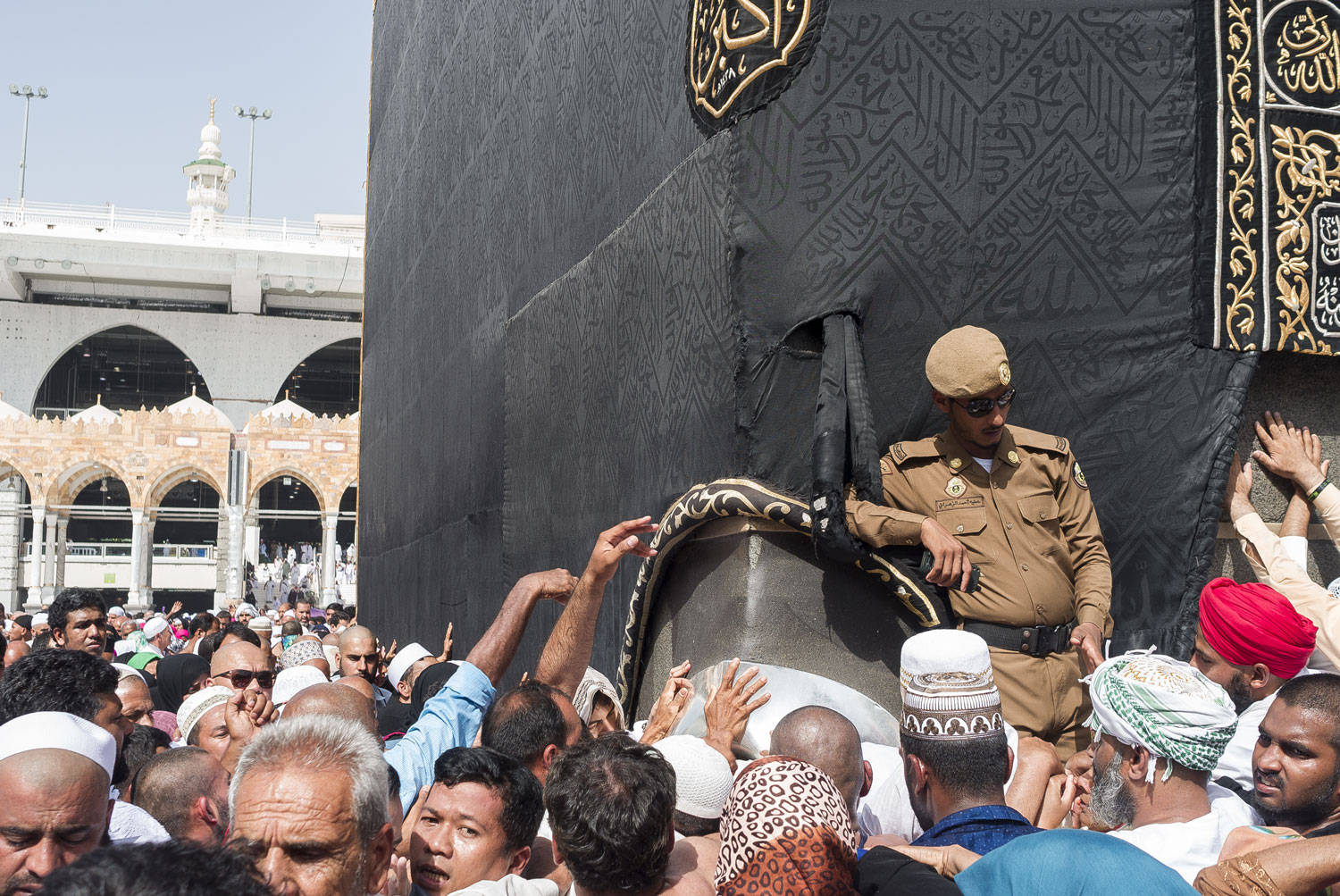
I reached out to it with my hand. Touched the silver frame. Started lowering my hand down. It seemed that one more centimeter, and I would touch it.
But inside the frame was someone’s head. Realizing that just a little more, and the crowd would carry me to the edge of the mosque, I began gently pulling the head by the front, however the head clung to the stone so tightly and for so long that it seemed like the Black stone was not kissed but given cunnilingus.
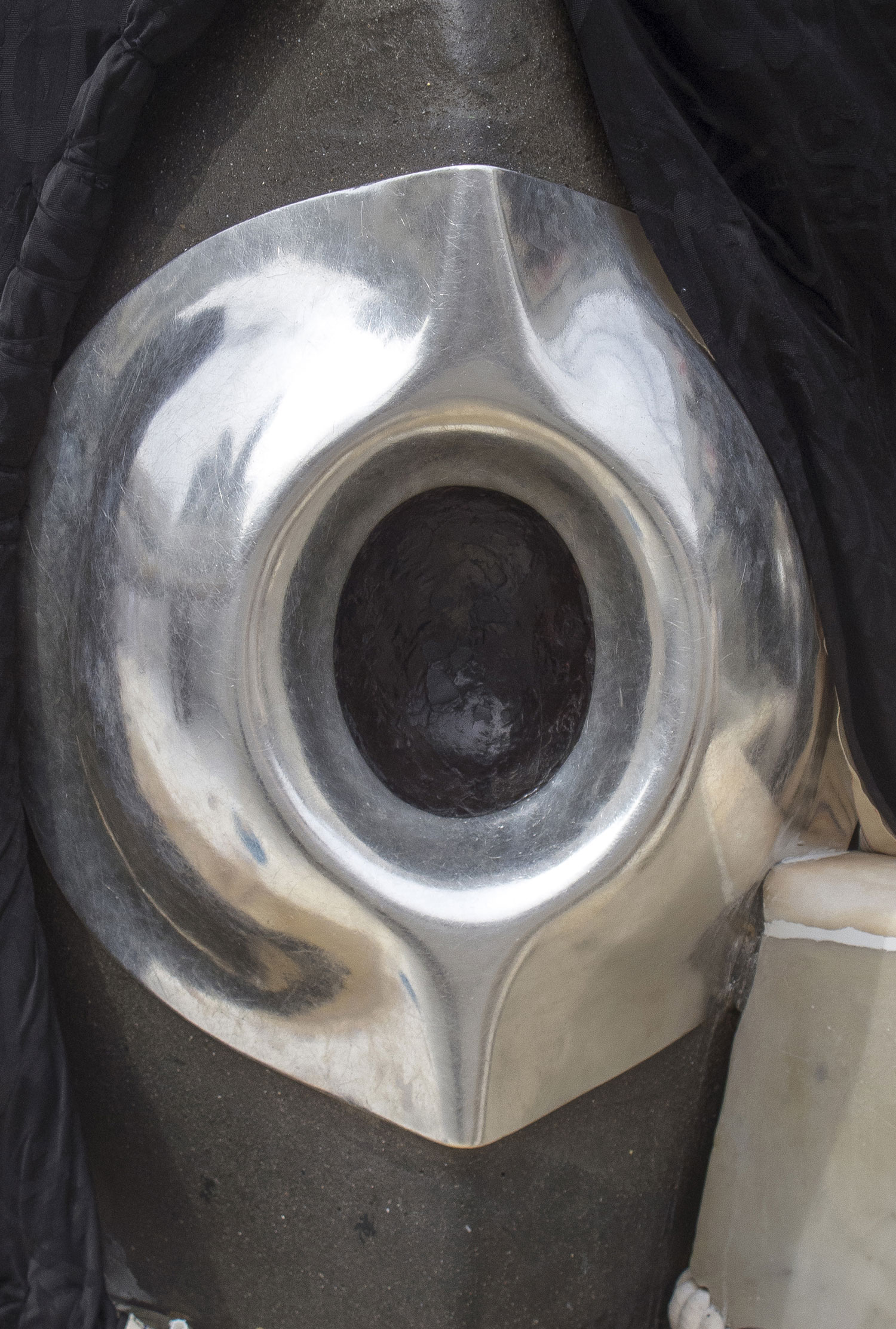
Shirt cracked in half. I realized I would crack next. Immediately I was thrown back by the crowd for several meters. Whole body was shaking from efforts. I never touch the stone.


